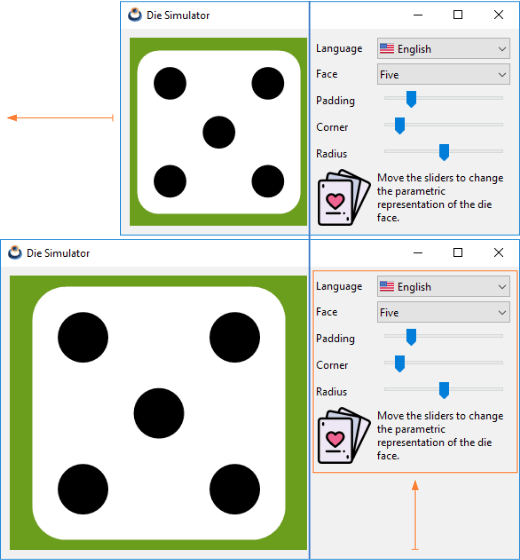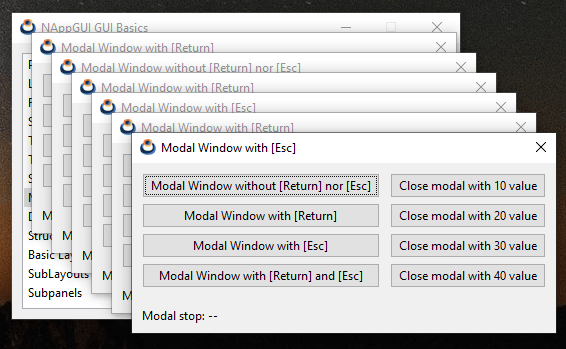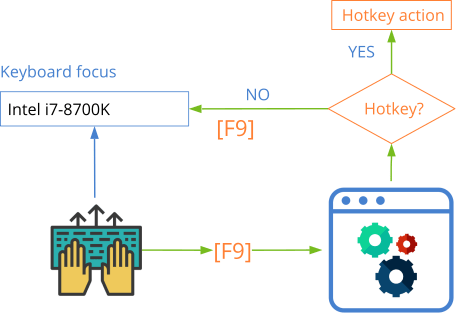Window
This page has been automatically translated using the Google Translate API services. We are working on improving texts. Thank you for your understanding and patience.
Functions
| Window* | window_create (...) |
| void | window_destroy (...) |
| void | window_panel (...) |
| void | window_OnClose (...) |
| void | window_OnMoved (...) |
| void | window_OnResize (...) |
| void | window_title (...) |
| void | window_show (...) |
| void | window_hide (...) |
| uint32_t | window_modal (...) |
| void | window_stop_modal (...) |
| void | window_hotkey (...) |
| void | window_cycle_tabstop (...) |
| gui_focus_t | window_next_tabstop (...) |
| gui_focus_t | window_previous_tabstop (...) |
| gui_focus_t | window_focus (...) |
| GuiControl | window_get_focus (...) |
| void | window_update (...) |
| void | window_origin (...) |
| void | window_size (...) |
| V2Df | window_get_origin (...) |
| S2Df | window_get_size (...) |
| S2Df | window_get_client_size (...) |
| void | window_defbutton (...) |
| void | window_cursor (...) |
Window objects are the top-level containers within the user interface (Figure 1). They are made up of the title bar, where the close, maximize and minimize buttons are located, the interior zone and the frame. If the window supports resizing, said frame can be dragged with the mouse to change its size. The interior zone or client area of the window is configured by means of a main Panel. In Hello World! you have a simple example of composing and displaying a window.
- Use window_create to create a window.
- Use window_panel to assign the main panel.
- Use window_show to show a window.
- Use the ekWINDOW_TITLE flag to include the title bar.
- Use window_title to assign a title.

1. Window size
In principle, the size of the window is calculated automatically based on the Natural sizing of its main panel, but it can be altered at any time.
- Use window_size to resize the main panel.
- Use the ekWINDOW_MAX flag to include the maximize button in the title bar.
- Use the ekWINDOW_MIN flag to include the minimize button in the title bar.
- Use the ekWINDOW_RESIZE flag to create a window with resizable borders.
The change in the dimensions of the client area implies a re-location and re-sizing of the interior controls. This is handled automatically by Layout objects based on how their Cell expansion has been configured, which will propagate recursively through all sublayouts. In Die you have an example of resizing a window (Figure 2).

2. Closing the window
Normally a window is closed by pressing the [X] button located to the right of the title bar. But sometimes it can be useful to also close it with the [ENTER] or [ESC] keys. Closing a window implies hiding it, but not destroying it. That is, we can show an already closed window again using window_show. In the case that the closing is conditioned to a state of the application, such as saving a file for example, we must assign a handler through window_OnClose and decide there whether to close it or not.
- Use window_hide to hide a window.
- Use window_destroy to permanently destroy a window.
- Use the ekWINDOW_CLOSE flag to include the close button in the title bar.
- Use the ekWINDOW_RETURN flag to enable
[ENTER]closing. - Use the ekWINDOW_ESC flag to enable
[ESC]closing. - Use the window_OnClose flag to prevent the closing of a (Listing 1) window.
1 2 3 4 5 6 7 8 9 10 11 |
static void i_OnClose(App *app, Event *e) { const EvWinClose *params = event_params(e, EvWinClose); if (can_close(app, params->origin) == FALSE) { bool_t *result = event_result(e, bool_t); *result = FALSE; } } ... window_OnClose(window, listener(app, i_OnClose, App)); |
Destroying a window implicitly destroys all of its internal elements and controls.
3. Modal windows
They are those that, when launched, block the previous window (or parent) until it is closed (Figure 3). Being "modal" or not is not a characteristic of the window itself, but of the way it is launched. In Hello Modal Window! you have an example of use.
- Use window_modal to display a window in modal mode.
- Use window_stop_modal to hide it and stop the modal loop.

After calling window_modal, the program stops at this point, waiting for the window to close, which can be done using [X], [ENTER], [ESC] or by calling window_stop_modal (Listing 2). The value returned by this function will be:
- ekGUI_CLOSE_ESC (1). If the modal window was closed by pressing
[ESC]. - ekGUI_CLOSE_INTRO (2). If the modal window was closed by pressing
[ENTER]. - ekGUI_CLOSE_BUTTON (3). If the modal window was closed by pressing
[X]. - The value indicated in window_stop_modal.
1 2 3 4 5 6 7 8 9 10 11 12 13 14 15 16 17 18 19 20 21 22 23 24 25 26 27 |
static void i_OnAcceptClick(Window *window, Event *e) { window_stop_modal(window, 300); } Window *window = i_create_window_with_accept_button(); // The program will stop HERE until window is closed uint32_t ret = window_modal(window); if (ret == 1) { // Closed by ESC } else if (ret == 2) { // Closed by INTRO } else if (ret == 3) { // Closed by [X] } else if (ret == 300) { // Closed by window_stop_modal } window_destroy(&window); |
By default, the modal window will be hidden after receiving the call to window_stop_modal, but it will not be destroyed as we indicated above. On certain occasions (although not very common), we may want to relaunch the window after finishing the modal cycle without producing an unsightly "flicker" due to a new (and fast) display after closing the window.
- Use the ekWINDOW_MODAL_NOHIDE flag when creating the window to prevent it from being hidden after the modal loop.
4. Keyboard focus
There are applications that make intensive use of the keyboard, or even do without the mouse. This is why we have to be very clear about how the different elements behave when pressed. The control that currently receives the keystrokes is called keyboard focus. Bla bla bla.
- Use window_focus to change the keyboard focus.
- Use window_get_focus to get keyboard focus.
On the other hand, it may be useful to move the keyboard focus from the code itself and not wait for the user to press [TAB]. In Hello IP-Input! you have several Edit that pass to the next control when exactly three numbers are entered.
- Use window_next_tabstop to move focus to the next control.
- Use window_previous_tabstop to move focus to the previous control.
Typically, tabstops will work cyclically (by default). That is, if the last control in the window has the keyboard focus and we press [TAB], the focus will go back to the first control in the window (cycle), as we see in (Figure XX). It is possible to disable this behavior, leaving the focus fixed on the last control even if we repeatedly press the [TAB] key. Likewise, the focus will remain fixed on the first control in the window even if we press [SHIFT]+[TAB].
- Use window_cycle_tabstop to enable/disable cycling tabstops.
5. Default button
- Use window_defbutton to set the default button.
6. Hotkeys
Normally, the keyboard focus will be fixed to some control inside the window like Edit, Button or View. But it is possible that we want to define global actions associated with a specific key.
- Use window_hotkey to assign an action to a key.
hotkeys will take precedence over keyboard (Figure 4) focus. That is, if we have an action linked to the [F9] key, it will be executed when the key is pressed and the ekGUI_EVENT_KEYDOWN(F9) event will not be received by the control that has the focus.

window_create ()
Create a new window.
Window* window_create(const uint32_t flags);
| flags | Combination of window_flag_t values. |
Return
The window.
window_destroy ()
Destroy the window and all its contents.
void window_destroy(Window **window);
| window | The window. Will be set to |
Remarks
Panels, layouts and components will be recursively destroyed.
window_panel ()
Associate the main panel with a window.
void window_panel(Window *window, Panel *panel);
| window | The window. |
| panel | Main panel, which integrates all the content of the window (views, controls, etc). |
Remarks
The size of the window will be adjusted based on the Natural sizing of the main panel.
window_OnClose ()
Set an event handler for the window closing.
void window_OnClose(Window *window, Listener *listener);
| window | The window. |
| listener | Callback function to be called before closing a window. |
Remarks
See Closing the window.
window_OnMoved ()
Set an event handler for moving the window on the desktop.
void window_OnMoved(Window *window, Listener *listener);
| window | The window. |
| listener | Callback function to be called as the title bar is dragged and the window moves across the desktop. |
Remarks
See GUI Events.
window_OnResize ()
Set an event handler for window resizing.
void window_OnResize(Window *window, Listener *listener);
| window | The window. |
| listener | Callback function to be called as the outer edges of the window are dragged to resize. |
Remarks
The resizing and relocation of elements is done automatically based on the main Layout, so it is not usually necessary for the application to respond to this event. See GUI Events.
window_title ()
Set the text that will display the window in the title bar.
void window_title(Window *window, const char_t *text);
| window | The window. |
| text | UTF8 C-string terminated in null character |
window_show ()
Show the window. By default windows are created hidden. You have to show them explicitly.
void window_show(Window *window);
| window | The window. |
window_hide ()
Hide the window.
void window_hide(Window *window);
| window | The window. |
window_modal ()
Launch a window in modal mode.
uint32_t window_modal(Window *window, Window *parent);
| window | The window. |
| parent | The parent window. |
Return
Value returned by window_stop_modal.
Remarks
parent stop receiving events until you call window_stop_modal.
window_stop_modal ()
Ends the modal cycle of a window.
void window_stop_modal(Window *window, const uint32_t return_value);
| window | The window previously launched with window_modal. |
| return_value | Value to be returned window_modal. |
window_hotkey ()
Sets an action associated with pressing a key.
void window_hotkey(Window *window, const vkey_t key, const uint32_t modifiers);
| window | The window. |
| key | The key. |
| modifiers | Modifiers. |
Remarks
See Hotkeys.
window_cycle_tabstop ()
Activate or deactivate the cyclic behavior of tabstops.
void window_cycle_tabstop(Window *window, const bool_t cycle);
| window | The window. |
| cycle |
|
Remarks
See Tabstops.
window_next_tabstop ()
Moves keyboard focus to the next control in the tab-list. It has the same effect as pressing [TAB].
gui_focus_t window_next_tabstop(Window *window);
| window | The window. |
Return
Result.
window_previous_tabstop ()
Moves the keyboard focus to the previous control in the tab-list. This has the same effect as pressing [SHIFT]+[TAB].
gui_focus_t window_previous_tabstop(Window *window);
| window | The window. |
Return
Result.
window_focus ()
Set keyboard focus to a specific control.
gui_focus_t window_focus(Window *window, GuiControl *control);
| window | The window. |
| control | The control that the focus will receive. |
Return
Result.
window_get_focus ()
Gets the control that keyboard focus has.
GuiControl window_get_focus(Window *window);
| window | The window. |
Return
The control.
window_update ()
Recalculate the position and size of the controls after modifying any Layout.
void window_update(Window *window);
| window | The window. |
window_origin ()
Move the window to specific desktop coordinates.
void window_origin(Window *window, const V2Df origin);
| window | The window. |
| origin | Position |
window_size ()
Set the size of the client area of the window.
void window_size(Window *window, const S2Df size);
| window | The window. |
| size | Main panel size. |
Remarks
The final size will depend on the window frame and desktop theme settings. This measure only refers to the interior area.
window_get_origin ()
Get the window position.
V2Df window_get_origin(const Window *window);
| window | The window. |
Return
Position (x,y) from the upper-left corner of the window.
window_get_size ()
Get the total dimensions of the window.
S2Df window_get_size(const Window *window);
| window | The window. |
Return
Window size.
Remarks
The frame and title bar are taken into account.
window_get_client_size ()
Get the dimensions of the client area of the window.
S2Df window_get_client_size(const Window *window);
| window | The window. |
Return
Main panel size.
window_defbutton ()
Set the default window button. It will be activated when pressed [Intro].
void window_defbutton(Window *window, Button *button);
| window | The window. |
| button | The button. |
window_cursor ()
Change the mouse cursor.
void window_cursor(Window *window, const gui_cursor_t cursor, const Image *image, const real32_t hot_x, const real32_t hot_y);
| window | The window. |
| cursor | Identifier of the new cursor. |
| image | Custom image. Only valid in ekGUI_CURSOR_USER. |
| hot_x | The x coordinate of the click point. Only valid in ekGUI_CURSOR_USER. |
| hot_y | The y coordinate of the click point. Only valid in ekGUI_CURSOR_USER. |
Remarks
hot_x, hot_y indicate the "sensitive" point within the image, which will indicate the exact position of the mouse.


